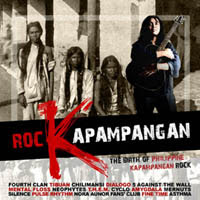Jason Paul Laxamana
Central Luzon Daily
This Wednesday, Infomax-8, a Kapampangan cable channel based in the City of San Fernando, and Kalalangan Kamaru, a creative team of multidisciplinary Kapampangan youth, will be presenting to the public the latest offering of Kapampangans to the rest of the world—Kalam, the first ever Kapampanganovela (Kapampangan television drama) in the history of Philippine broadcasting. It will take place at the Event Center of SM City Pampanga, 5 PM, and is bound to be a grand Kapampangan event as it will feature not only various Kapampangan performances, but also the public screening of the pilot episode.

Making the Kapampangan youth as its target audience, Kalam tackles the life and adventures of a new generation of witches and healers (gifted people, or in Kapampangan, ding ating kalam) born in urban Pampanga and how they struggle to fit in a skeptical, discriminating, and fearful society. It will be an exciting mix of urban fantasy, action, romantic comedy, drama, and social relevance, while using Kapampangan culture—both past and present, folk and modern, rural and urban—as canvass.
A clear history of the development of Kapampangan mass media is not yet available, albeit, inspired by the so-called Kapampangan cultural renaissance happening in the province, several mass communication students in and out of the province are beginning to take interest in outlining our media history as their thesis. Nevertheless, the production of Kalam is certainly a milestone.
Just what does having a Kapampangan TV drama imply?
Panyulung Pangkultura (Cultural Development)
First of all, we see a huge leap in what we call cultural development, as having a Kapampanganovela means that Kapampangans now officially know how to make a TV series, the process of which requires diverse skills from a well-coordinated team of people.
These skills include: research, story conceptualization, scriptwriting, directing, camera operation, cinematography, acting, talent management, production design, makeup and costume design, audio editing, and video editing. But television is more than a creative effort. Production management, location management, marketing, programming, publicity (which involves graphic design and large-scale printing, coordination with the press, and public relations), sales, advertising, financial management, budgeting, broadcasting, to name some more, are also involved, and Kalam boasts of an all-Kapampangan staff, cast, and crew. This means that all the skills I've mentioned and have failed to mention are now part of the growing Kapampangan culture.
Whether Kapampangans are bound to excel in the field of TV drama production and cause a “Kapampangan wave” (synonymous to the recent “Korean wave” phenomenon) is something to look forward to. Looking at our past achievements, however, we can conclude—not necessarily meaning we can be complacent—we can excel. Look at our lanterns compared to the rest of the Filipinos'.
Sagisag Kapampangan (Kapampangan Symbol)
Second implication is the growing awareness of Kapampangans that they, indeed, are a people who have their own identity apart from their Filipino and Asian brothers, and this road to cultural self-determination has extended to the field of TV drama production.
Kapampangans used to and still rely on the Tagalogs, the Koreans, the Taiwanese, the Mexicans, the Japanese, and the Americans when it comes to satisfying their television entertainment needs. If a Kapampangan wants to watch a TV drama, he tunes in to ABS-CBN, GMA-7, TV-5 or other channels. Or perhaps, he would run to the nearest bangketa to find the vast array of pirated DVDs of Korean, Japanese, and Chinese TV series. But what do we see in these foreign productions but foreign culture where Kapampangan is nowhere to be found, except probably in lousy cases like the Kapampangans in ABS-CBN's Kokey (where Kapampangans are exaggeratedly portrayed as letter H-deficient people) and the divine character Sinukuan in Dyosa (where Sinukuan is an Arabian-looking princess).
Such lack of Kapampangan symbols cause the alienation—inferiority complex, even—of the Kapampangans, particularly the youth who are heavy media consumers, to their own culture, including language, and identity. Now that we have a TV drama of our own, expect familiarity, as various symbols are bound to make Kapampangans see themselves more in the boob tube—not as “colored people,” but as diverse people who think, feel, face problems, come up with solutions, excel, fail, cook, eat, photograph, love, hate, philosophize, obey the law, break it, dream big, dream small, etc.
It's time to determine who we really are using television instead of relying on others to portray us, for if we remained in the level of dependence on Manila media, we will forever be H-deficient, gegege people who excel only in domestic work and pamagmais. We will never be portrayed as lawyers, philosophers, scientists, matinee idols, modern activists, political leaders, doctors, etc.
The presence of Kalam, however, is a symbol itself. It is an addition to the symbols that unify us as a separate ethnolinguistic community, which include the Kapampangan language, Kapampangan cuisine, Kapampangan literature, Kapampangan heroes, Kapampangan history, Kapampangan landmarks, Kapampangan icons, and Kapampangan songs and hymns.
I wonder when the time will come when Kapampangans cease importing entertainment from outsiders (including territories outside the Kapampangan region) and start making their own media products for export in other parts of the world.
Primerung Pasinag (Grand Premiere)
Given these two big implications, we hope you would support Kalam, as its success will be the success of Kapampangans. It's also a nice way to celebrate the Bulan Na Ning Amanung Sisuan (Language Month). Please review the first paragraph for the event details. Visit http://kalamtv.blogspot.com for more information about the series.












